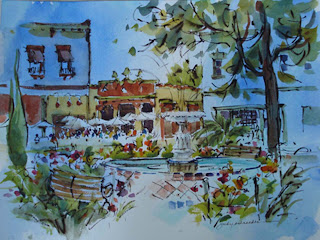I have been doing a version of ink and watercolor at least since high school. In 2001, I began to use it more frequently and made a habit of taking small handmade watercolor paper with me on travel workshops using a roller ball pen with water-soluble ink. I liked the way the ink moved and ran as I worked, creating passages within the piece. That led to a chapter in “Work Small, Learn Big,” a book on sketching in pen and watercolor published by International Artist Magazine in 2003.
Subsequently, I wanted to work in a larger format, but the small pens were not appropriate for that. I finally found a watersoluble ink brush with a cartridge in the Daniel Smith catalog…a brush pen used for sumei. It took awhile to get the courage to spend over $60 for the Kaimei brush pen, but when I did and used it for the first time, I was hooked. Finding the brush pens is now easy…D. Smith still carries them and typing “oriental brush pen” in a search engine leads to many more sources.
Recently I found a brush pen with sepia ink and I like the warmer tones of the brown ink. Here is one of the most recent, a painting of the southwest quadrant in Old Towne Orange’s Plaza Square. In this case the under-painting in blue was done before I went out to paint. I find that I like the results better if the under-painting is done with no thought of the subject matter to be superimposed on top. When I begin to draw, I watch the placement of the shapes to make best use of the lighter areas and draw directly in ink. My brush pen basically goes for a dance across the page and my drawings are more fluid with this technique. Watercolor is applied when the line drawing is complete and if done immediately the ink blends with the watercolor. If you wait a number of days, the ink is set and washes can be applied across the line with no bleeding. You lose the variation in edge quality however.
The addition of ink to watercolor is especially helpful when working in a sketch book with limited time. If you have a good line drawing, you can add minimal watercolor paint to have a good representation of the scene. And by holding back a bit on the brush pen, the line can be less powerful in a smaller format.



1 Comment
Judy
August 5, 2010Very impressive site, informative as well as showing a beautiful example in the painting of Old Towne Orange Plaza; your description should be inspiring to many of us watercolor artists and students alike! I too like to mix other media sometimes, such as ink with watercolor. Your approach is fresh and free, very nice indeed. Thanks, Judy Coyle, "the Brush Lady".